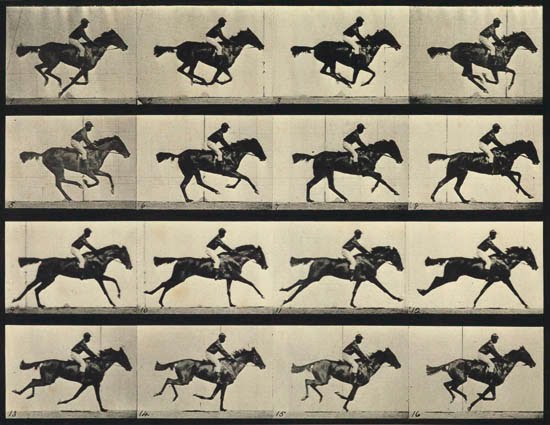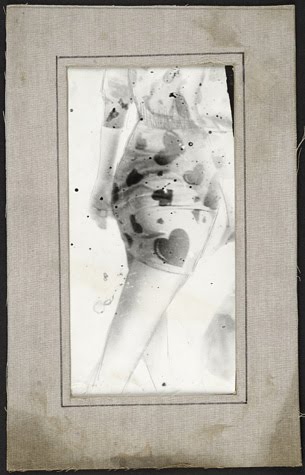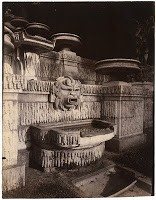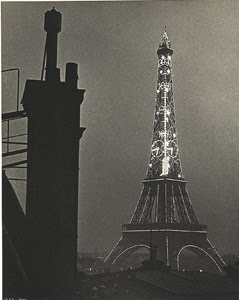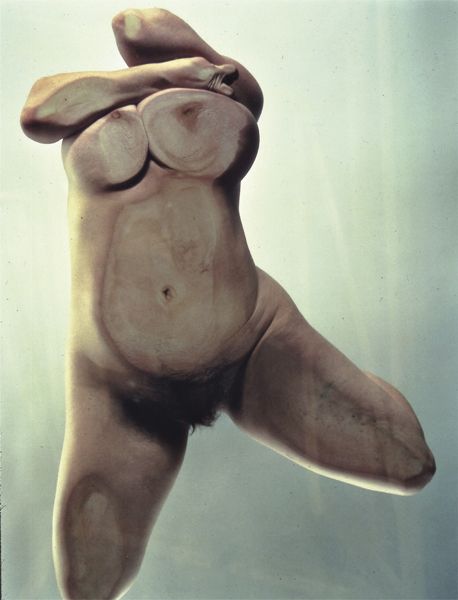Parts 1, 2, and 3, of this multi-part AIPAD post can be found here, here, and here.
While the first three parts of this review chronicle the details of the booths and the images contained there, I had a few other higher level observations and conclusions that I wanted to add in the hopes of creating a more complicated picture of this show. We’ve given you the laundry list of photo information; now here are a few ideas to chew on. In no particular order, they are as follows:
1.) In talking with lots of different gallery owners over the course of the show, I’m more convinced than ever that the photo market slowdown we’ve seen in the past few years was a result of reductions of both supply and demand. Not only did many collectors/museums pull back on their purchases from a demand perspective, the supply of top tier pictures also dried up, as owners were far less willing to sell into the teeth of a headwind. The consensus opinion of the gallery owners I talked to was that both supply and demand are starting to loosen up a bit again, with mid tier and lower end collectors regaining some financial confidence, and top tier collectors (who never really went away) beginning to see pieces of the finest quality and rarity start to reappear.
2.) After coming to AIPAD for quite a few years now, I’ve come to the conclusion that the best thing about this show is what I would call “the discovery of the old”. I think there is really no better place to find the amazing, the forgotten, the unseen, the variant, or the unusual in vintage photography. Every year I am introduced to several vintage photographers who I have never heard of and who have made superlative work, but are outside the mainstream a bit. And there are also always prints by photographers I think I know well that surprise and delight me.
While there was more contemporary photography at this year’s fair than ever before (at least that I can remember), and with sincere apologies to those galleries who showed predominantly contemporary work this year, I don’t think AIPAD is a particularly good place for “the discovery of the new”. Since it is now the time of the NCAA college basketball tournaments (men’s and women’s) in the United States, allow me to use a basketball analogy for a moment. Imagine we were to set up a contemporary photography “tournament” (I know, I know, art isn’t exactly a winners and losers exercise but bear with me), but instead of having the normal 64 team field, we did the following. First, let’s strip out the top 15-20 powerhouse teams (galleries or artists in this case) from the tournament field. Second, let’s strip out the bottom 15-20 newcomers, underdogs, and fresh faces as well. This leaves the solid middle of the field to play in the tournament; once all the games were finished, what would we have learned or what conclusions could we draw from this pared down event? Not much I fear.
Unfortunately, to my eye, this is exactly what is happening with contemporary photography at AIPAD. While there are plenty of strong specialist galleries that show contemporary photography from all over the planet, the fact remains that virtually all of the top photographer/artists in the world are represented not by photography specialists, but by contemporary art galleries. Really, how can we have a show of the best of contemporary photography without Gursky, Sherman, Sugimoto, Close, Prince, Eliasson, Ruff, Muniz, Struth, Graham, Avedon, Hofer, Neshat, Kruger, Soth, Wall, Opie, Tillmans, or Sternfeld (or pick any other of your favorites that I may have missed); none of these were represented at this year’s AIPAD as far as I could tell.
I think AIPAD is the right “brand” to deliver on “the discovery of the new”, but it will require some out of the box thinking. My suggestion is to split the current fair into two fairs. AIPAD Vintage would gather work from the beginning of the medium to approximately 1980. All the booths would show only this kind of work. No exceptions. Schedule it in October, in line with the Fall auction season. It will draw the vintage collectors just like it always has, only there will be a more focused atmosphere. AIPAD Contemporary would gather work from 1980 onward. Schedule it in late March as usual, but not opposite the Armory, ADAA or Maastrict. AIPAD will need to create an ancillary membership category for those contemporary galleries that represent photography as part of their stable, but not as a primary focus. Perhaps a combination of lower dues or booth discounts will be needed, but the goal must be to attract the best galleries to participate and bring only their photography (I would suggest the following from New York as a short list: Gagosian, Sonnabend, David Zwirner, Matthew Marks, Metro Pictures, Sikkema Jenkins, Luhring Augustine, Gladstone, Marian Goodman, Jack Shainman, Sean Kelly, Von Lintel; add your favorites from around the world as well). There also needs to be a way to bring in a group of younger, international galleries with less established work; set up the vetting however you like, but bring in some emerging work to add to the mix. If these things were done, and added to the existing core of great contemporary galleries/dealers who are already AIPAD members, and now we’d actually have a show that would cover the complex world of contemporary photography with some distinction (and attract a broad audience). No one has done this yet, at least in America, and AIPAD has the best chance to do it well, given its historical relationships with collectors.
While I’m sure there are some collectors who collect both Gustave Le Gray and Thomas Ruff, I think this is a relatively small (but likely elite) group. Many collectors focus on one or the other (vintage or contemporary), and breeze by the other booths as though they were invisible. I have often said that I enjoy the juxtaposition of old and new, but I don’t think AIPAD can scale to be everything to everybody without doubling or tripling in size, and more photo specialists doesn’t fix the problem; contemporary photography is just moving too fast. A more focused approach would create more interesting connections and interplays and less dissonance. If we have to go to two fairs, so be it. And an added benefit of this approach (at least from my perspective) is that the focused fairs will eliminate those booths that try to cover the history of photography on three walls with 20 pictures, and encourage both tighter editing and more single artist displays.
Feel free to dismantle this strawman idea in the comments, as I’m certainly open to other good ideas, but I think this is the most straightforward way to leverage the strengths of AIPAD to deliver on an important unmet need in the world of contemporary photography. AIPAD is about excellence in all facets of photography and the membership should take a leadership position in defining the best of contemporary photography, rather than ceding that task to others.
3.) I had the wonderful opportunity to meet individually with a handful of the top photography collectors in the United States during AIPAD this year. While collector bashing has become a common activity on the Internet (particularly as related to the current New Museum show), I was entirely blown away by the level of intellectual rigor and seriousness with which these collectors are applying themselves. These people are experts; there is no other appropriate word for their scholarly approach to the medium. In many cases, given their deep knowledge, these collectors are out ahead of the museum curators and gallery owners, digging into areas they find of interest, unearthing forgotten photographers or unexpected rare prints, filling in the gaps in the historical record. Universally, they seem to be passionate, driven, and quietly competitive people, searching for the absolute best and accepting nothing less. I suppose it is like most things, in that as one rises to the top echelon in any activity, the level of talent, effort and resources applied to the task gets higher and higher, and the competition gets far stiffer. As a very small fish in the collecting pond, it was clear that these folks are playing an entirely different game than we are, but I could also see a future where we slowly evolve toward this group, learning from them as we go, gathering more and more education and refining our eye as the years pass.
As a less than important aside, the VIP card system at the show is in need of some significant tuning. Virtually none of the major collectors I talked with had the cards, which made the fact that I had one both embarrassing and somewhat ridiculous. Regardless of whether a specific gallery put a name on a list, AIPAD should generate a list of the top photography collectors/curators worldwide and give these people cards irrespective of who is the named sponsor. These people should feel entirely welcomed; in actual fact, many were muttering and scratching their heads. In the end, I gave my card to someone far more deserving than I, which was probably against the rules, but seemed to be altogether appropriate given the circumstances.
All in, as always and regardless of my nitpicks and suggestions above, I had a tremendous time at this year’s AIPAD. The look of the show itself was better than ever (I liked the use of more colored walls), and there was plenty of exciting work and a high density of fascinating people; overall, it was more to take in than is humanly possible. I was happy to meet all of you who reached out to say hello, and for those I missed in my whirlwind tour, we’ll see you next year.
 JTF (just the facts): A total of 74 black and white photographs, framed in black and matted, and hung in the main gallery and smaller back room spaces. All of these prints are gelatin silver prints, taken in 2010, roughly 18×12 or reverse, and printed in editions of 3. There are also 4 large scale c-prints on display, framed in white with no mat. These works are roughly 110×72 or reverse, also in editions of 3. An exhibition catalogue of the black and white portraits has been published by Dashwood Books (here). (Installation shots at right.)
JTF (just the facts): A total of 74 black and white photographs, framed in black and matted, and hung in the main gallery and smaller back room spaces. All of these prints are gelatin silver prints, taken in 2010, roughly 18×12 or reverse, and printed in editions of 3. There are also 4 large scale c-prints on display, framed in white with no mat. These works are roughly 110×72 or reverse, also in editions of 3. An exhibition catalogue of the black and white portraits has been published by Dashwood Books (here). (Installation shots at right.)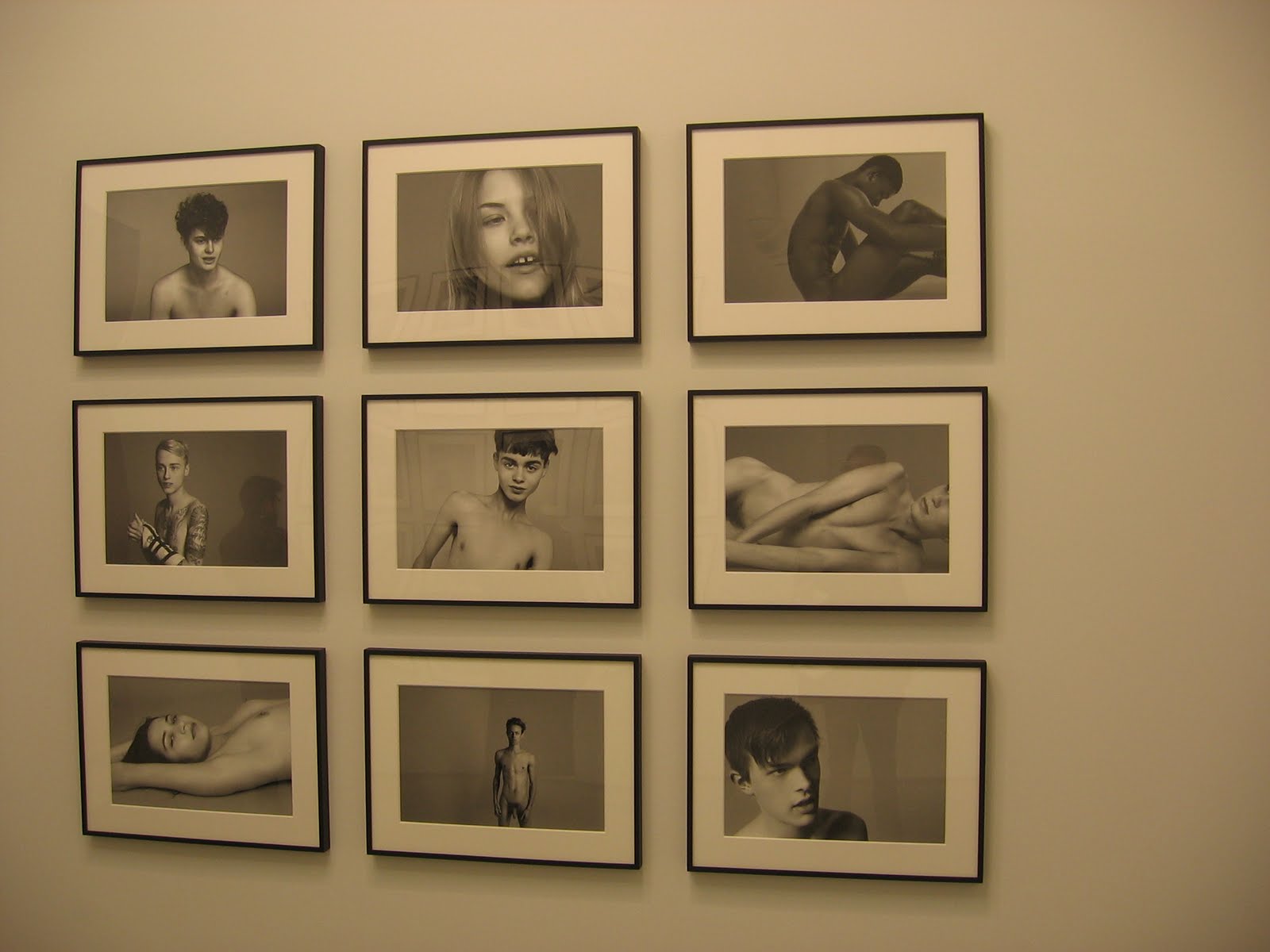 So what does a Ryan McGinley studio nude look like? For one thing, the frenetic energy and motion of his larger work is generally absent, as his models pose with shy, androgynous awkwardness against the uniform grey background – there are more quiet personal moments here, rather than zany antics and exuberant laughter. Second, his nudes are not particularly explicit or erotic; they trend more toward classic forms and fragmented body parts, with a large helping of faces to keep the pictures grounded in the specifics of single individuals. While a few too many of these images wander a bit too far into the well worn paths of the beautiful people who inhabit Abercrombie and Fitch ads (a little too perfect and retouched), in general, I came away impressed with McGinely’s ability to find tenderness and intimacy, to capture a genuine kaleidoscope of youthful emotions and moods.
So what does a Ryan McGinley studio nude look like? For one thing, the frenetic energy and motion of his larger work is generally absent, as his models pose with shy, androgynous awkwardness against the uniform grey background – there are more quiet personal moments here, rather than zany antics and exuberant laughter. Second, his nudes are not particularly explicit or erotic; they trend more toward classic forms and fragmented body parts, with a large helping of faces to keep the pictures grounded in the specifics of single individuals. While a few too many of these images wander a bit too far into the well worn paths of the beautiful people who inhabit Abercrombie and Fitch ads (a little too perfect and retouched), in general, I came away impressed with McGinely’s ability to find tenderness and intimacy, to capture a genuine kaleidoscope of youthful emotions and moods.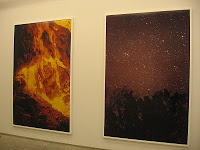 Collector’s POV: The black and white portraits in this show are priced at $5000 each; the larger c-prints are $25000 each. A few examples of McGinley’s work have recently started to become available in the secondary markets; prices have ranged between $2000 and $23000.
Collector’s POV: The black and white portraits in this show are priced at $5000 each; the larger c-prints are $25000 each. A few examples of McGinley’s work have recently started to become available in the secondary markets; prices have ranged between $2000 and $23000.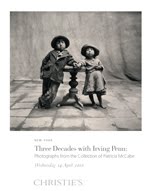
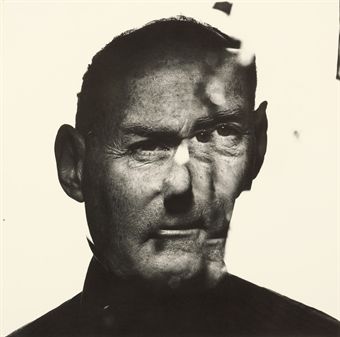
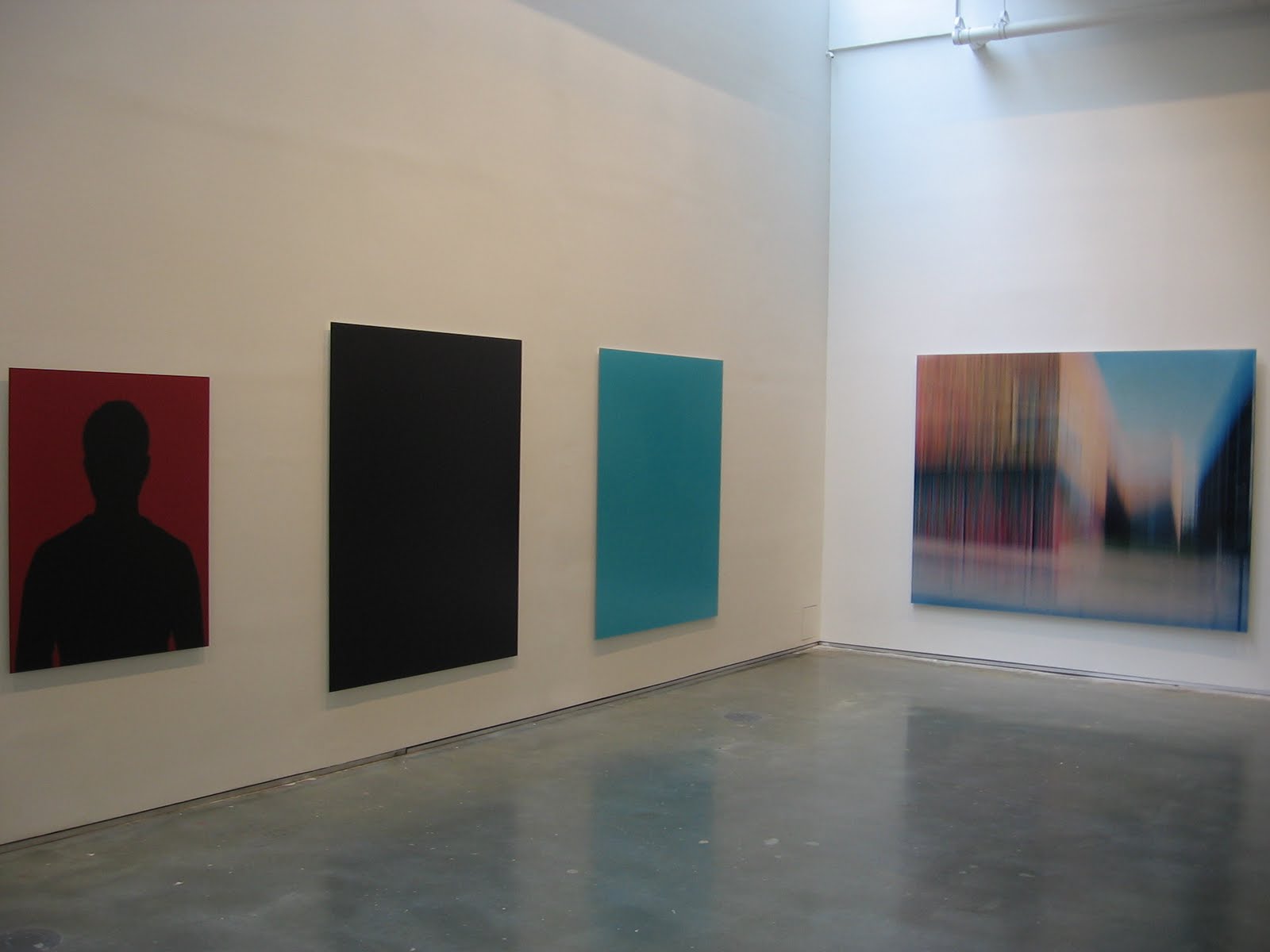
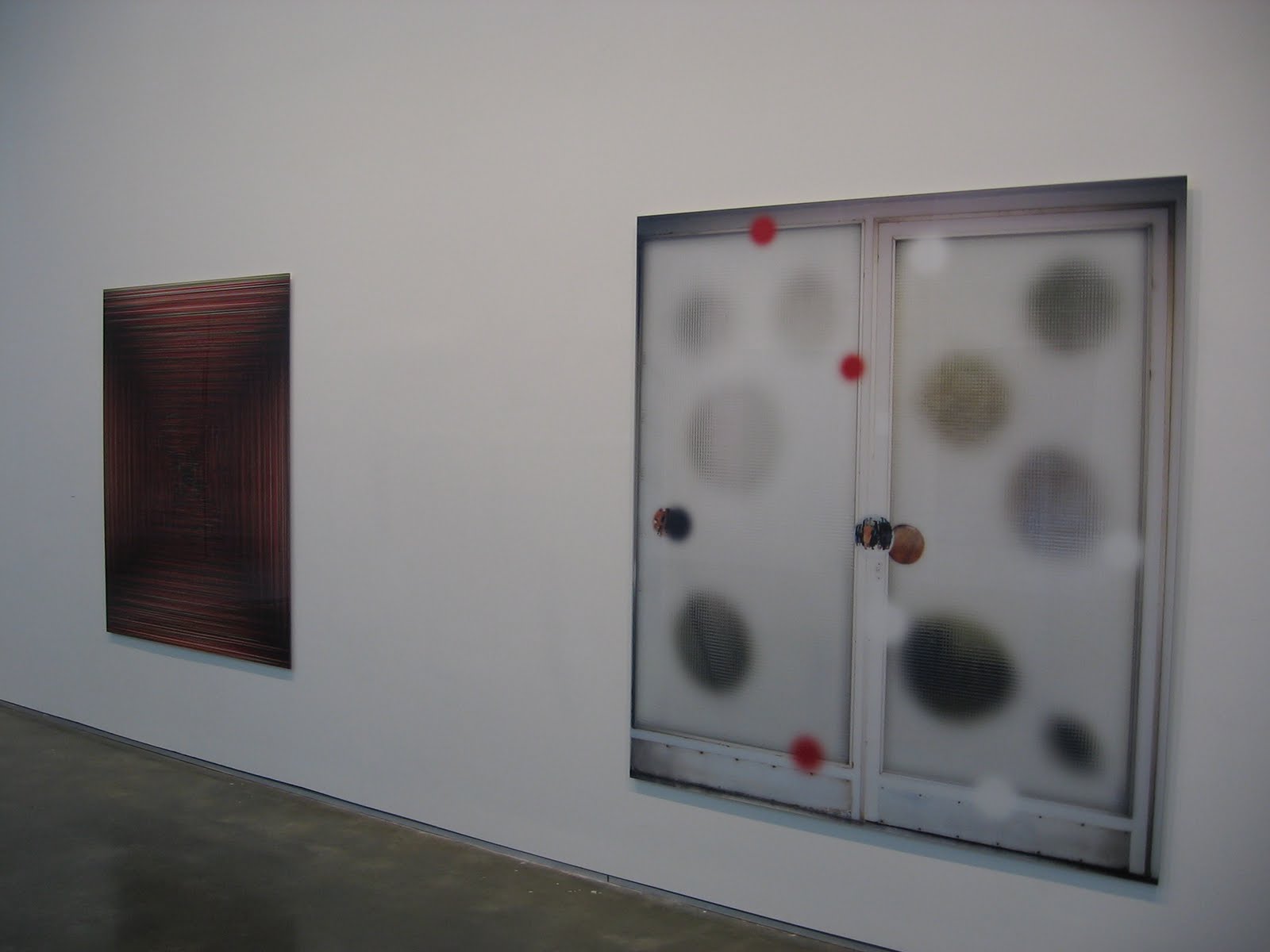
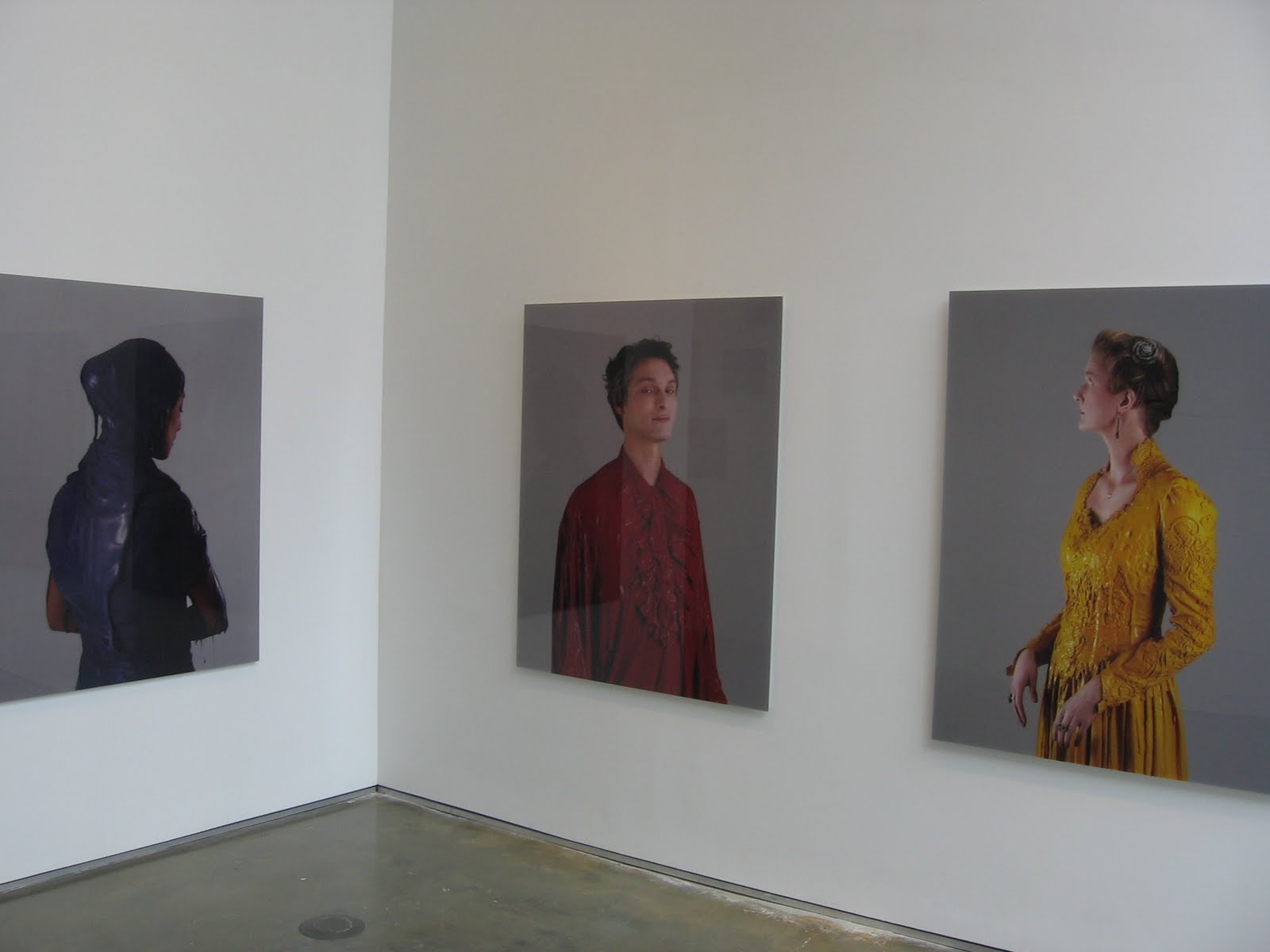

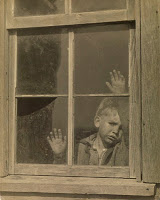 The results of Swann’s various owner photographs sale were altogether uneventful, with a buy-in rate over 35% and total sale proceeds that missed the estimate range by a pretty wide margin. Over 40% of the lots that did sell came in below the low estimate.
The results of Swann’s various owner photographs sale were altogether uneventful, with a buy-in rate over 35% and total sale proceeds that missed the estimate range by a pretty wide margin. Over 40% of the lots that did sell came in below the low estimate. 